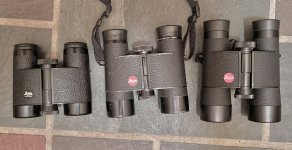Hermann
Well-known member

IMO the problems arose when you used them in the rain, i.e. when you used the focuser a lot. At least that's what seems to have happened on the two occasions when friends got water into their 10x40s on separate birding trips in the UK. That's quite different from just placing a pair in a fish tank full of water.B) And something very similar from an old review of a Swift Eaglet by Stephen Ingraham:
<snip|
'Some of us have fond memories of the old Leica (then Leitz) 7x35 Trinovid. For several decades they were the binoculars many a birder aspired to.
They were small, had a wide field and good eye relief, and, with some effort and expense, could be adjusted to focus closely.
Though they were never advertised as waterproof, I know of at least one Leica dealer who used to keep a pair in a fish tank full of water in his front window
and pull them out to demonstrate to customers.'
Hermann







